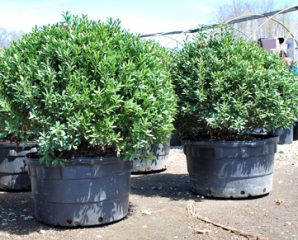Inkberry is a native shrub used in many designs mainly for it being an evergreen, deer resistant plant. Most often these are simply planted, watered and left to do their thing – which is fine – until it’s not. After about the third year you’ll begin to notice a legginess develop with most of the foliage towards the top third of the plant. That is easily avoided. How? By occasional selective pruning, check it out:
– First, know that Inkberry forms new buds at the cut site. They will not sprout new buds low down along a branch until pruned and or light hits the stem initiating growth of latent buds
– Trimming or shearing the top only encourages a thick dense canopy that prevents light from reaching inner twigs and branches and thus develops a leafless branching structure with leaves only at the tips
– Prune selectively by hand with sharp hand pruners cutting at an angle to hide your cuts
– Cut branches at varying heights inside the shrub (below the intended finished height) letting sunlight in and encouraging new buds to develop; always think in terms of thinning to let light into the interior structure
– Optimum time to prune is late winter/early spring before new growth begins
– Fertilize in spring with something like Holly-tone or 12-3-6 A.C.R.E. which are for acid loving plants like most Hollies (Ilex)
Remember, the main objective is to let sunlight inside by avoiding a congested dense top growth
– Also, they like moist, well-drained soil so supplemental watering is necessary during times of drought
Remember the hallmark for good pruning is after you are finished the average person walking by should not realize or notice that any pruning has been done!

